The MGA With An Attitude
WEBER Downdraft Carburetor MODIFICATION - CB-310
for Anti-Run-On, Fuel Vapor Recovery (and Positive Crankcase Ventilation)
 This may seem to be an odd subject for MGA, but fairly often there will be a downdraft Weber carburetor conversion in an MGA (sometimes along with an MGB engine transplant). When installation instructions are provided with the Weber carburetor kit, they are often wrong. The instructions commonly say to connect the front tappet cover vent to the air cleaner, which is guaranteed to defeat crankcase ventilation. That is bad for the engine, as crankcase ventilation is necessary to remove water vapor from the crankcase (water being a byproduct of combustion). Driving short trips with cool engine will result in water accumulating in the oil. Longer trips with warm engine will result in water condensing in the valve cover, which creates a scum in the valve cover looking like dirty Mayonnaise (emulsified water and oil). Driving a longer time in this condition will result in "rain" in the valve cover putting the water back into the oil sump. This is all very bad for the engine. If you want to continue with this condition you should change the engine oil every 1000 miles or so (which most people would never do).
This may seem to be an odd subject for MGA, but fairly often there will be a downdraft Weber carburetor conversion in an MGA (sometimes along with an MGB engine transplant). When installation instructions are provided with the Weber carburetor kit, they are often wrong. The instructions commonly say to connect the front tappet cover vent to the air cleaner, which is guaranteed to defeat crankcase ventilation. That is bad for the engine, as crankcase ventilation is necessary to remove water vapor from the crankcase (water being a byproduct of combustion). Driving short trips with cool engine will result in water accumulating in the oil. Longer trips with warm engine will result in water condensing in the valve cover, which creates a scum in the valve cover looking like dirty Mayonnaise (emulsified water and oil). Driving a longer time in this condition will result in "rain" in the valve cover putting the water back into the oil sump. This is all very bad for the engine. If you want to continue with this condition you should change the engine oil every 1000 miles or so (which most people would never do).
Aside from the bad instructions, crankcase ventilation is generally a separate issue, only related to the carburetor when vent intake air is taken from the carburetor air cleaner, or when the carburetor may be providing the vacuum source for Positive Crankcase Ventilation (like some SU carburetors, never done with these Weber Carburetors). So PCV (circa 1964) will be covered in a separate tech article. This article is otherwise primarily concerned with Fuel Vapor Recovery (circa 1970) and Anti-Run-On (circa 1972). It is possible to install Anti-Run-On without Vapor Recovery, which may be of interest to some MGA owners (due to run-on effect with alcohol in modern motor fuel). Vapor recovery is usually limited to those cars originally equipped with the carbon canister. Fuel vapor recovery is mentioned here because it goes hand in hand with anti-run-on, both of which require a sealed float chamber and external vent port in the carburetor, so both can be accommodated with the same carburetor modification.
When a Weber downdraft carburetor is installed in MGA or MGB prior to 1964, it is simple to connect the valve cover inlet vent to the air cleaner, and leave the draft pipe on the front tappet cover in place. Crankcase ventilation will work as original, pulling air in via the air cleaner and expelling crankcase fumes out the draft pipe. There will be no vapor recovery or anti-run-on (as original).
Between 1964 and 1967 MGB (18GA, GB, GF engines) had a PCV valve between front tappet cover and intake manifold. Those take intake air through a filtered (and restricted) oil filler cap, and can be left as original when the Weber carburetor is installed (no vent to the air cleaner required).
Beginning with 1968 MGB there was a carbon canister for fuel vapor recovery. The canister is connected to the fuel tank vent and to the carburetor float chamber vent(s). Purging of the canister requires atmospheric intake vent air to be drawn through the canister when running. This could be done with the prior PCV valve set-up, but MGB changed to using a venturi in the SU (and later Z-S) carburetor throat for the low-level vacuum source. The carbon canister serves as the air intake filter (no connection to the air cleaner required) while the intake restriction is in the connector tube on the rear end of the valve cover, and the oil filler cap is then sealed.
But this is where you get into trouble installing the Weber carburetor, because the Weber does not have a low-level venturi vacuum port or sealed float chamber or external vent port to the float chamber (three strikes and you're out). Beginning with 1972 MGB there was also anti-run-on function which requires the same sealed float chamber and external vent port. This is where we get to the field modification to the Weber carburetor.
When a Weber downdraft carburetor is installed on post 1967 cars (or when wanting anti-run-on for earlier cars), the carburetor needs to be modified. The tricky bit was to figure out how to seal the float chamber and provide an external port connection to be able to both vent and draw a vacuum on the float chamber.
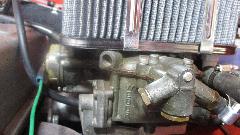
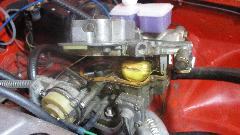
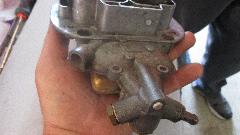
On this model carburetor there is a very nice side port just below the air cleaner that is "dead end" never drilled through. Here we will tap the port for 1/8-NPT pipe thread to install a hose barb, and drill a small hole underneath to connect this port into the float chamber. This provides the external vent for fuel vapor recovery and anti-run-on functions.

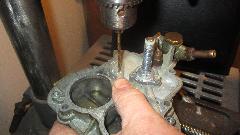
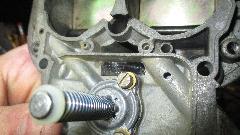
Inside the carb, the float chamber is vented through a rather large slot upward to the air cleaner. We can tape up the bottom of the slot, and mix up some epoxy to fill and plug this vent slot, allowing to draw a vacuum in the float chamber for anti-run-on function.
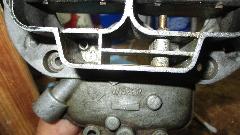

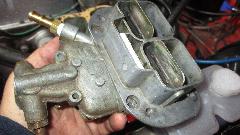
Then we can install a "T" fitting in the intake manifold. The lower port would have a small hose going to the anti-run-on valve, while the upper port would have a larger hose to connect an in-line PCV valve connecting to the front tappet cover vent hose. The manifold port had BSPP thread, and no adapter bushing available to convert to tapered pipe thread. We would have re-tapped the port to 3/8-NPT, but the local hardware store didn't have a tap that size. Then all attempts to drill and the old plug to make a reducer bushing failed with a bunch of dull drill bits (must have been a very hard forged plug). In the end we settled for a BSPP to hose barb fitting followed by a hose "T" and more hoses.
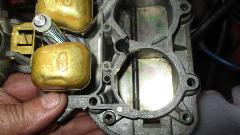

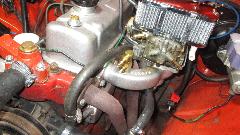
Tour day with British Motor Club of Montgomery Alabama, Sunday, February 19, 2017. Positive crankcase ventilation, fuel vapor recovery, and anti-run on all work. See if you can identify the valves and hoses for vacuum, vapor recovery, anti-run-on, and positive crankcase ventilation.

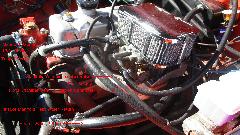

|